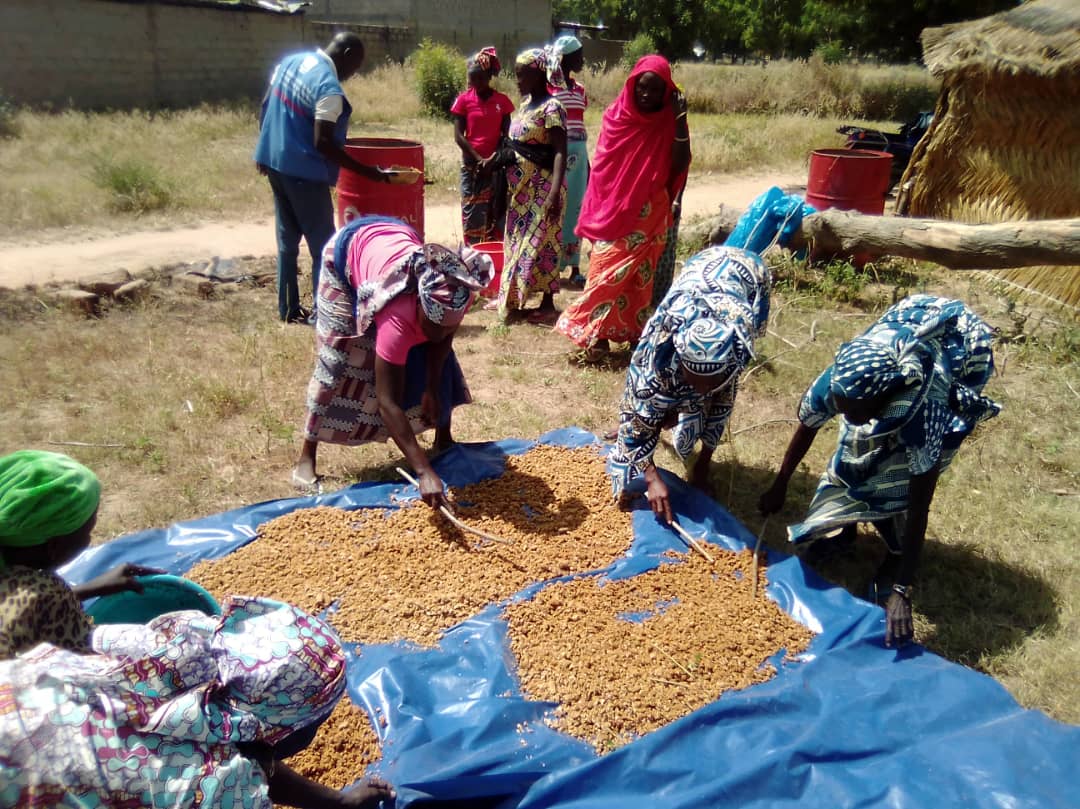Groundbreaking Workshop on AI and Technology-Facilitated Gender-Based Violence at AWiM24
Trending
Tuesday June 3, 2025
Trending

Kerawa
It is one of those hot mornings in the Kerawa Refugee Camp in Cameroon’s arid Far North region. So hot that by 8 AM, temperatures are soaring up to 47 degrees Celcius. A good number of the women and children displaced by the recent intercommunal clashes are up and about.
At one end of the makeshift settlement, sites are Halima and Yele. The two women in their mid-40s carry small plastic watering cans. These mothers have found a new way of growing their vegetables away from their farmlands and villages, come rain or sunshine.
“We get the soil and put it into empty bags of millet, big cans and even on a table-like surface and plastic papers,” explains Halima.
“We then add dry leaves and other biodegradable matter into the soil for manure. After some time we plant our crops,” she says.
The two women sprinkle water on the green plants while at the same time, trying to clear off the sprouting grass. This exercise has become a routine for displaced women.

“This is the second attempt,” Yele says. “The first enabled us to plant tomatoes, lettuce, “lalo” hibiscus known here as “folere” and okra,” she said.
“The yields weren’t the best, but we had a harvest of some vegetables.”
This agricultural system codenamed the “aboveground farming system” is just being experimented here. Since there is no arable land to meet the farming needs of the many women in the camp, this means of growing crops seems ideal. The farming method allows women to fill up small quantities of soil into cans, buckets, bags and other local items available. The women then add other matter into the soil like dry tree leaves which are broken into small pieces for manure, before seeds are planted. The bags or cans containing the seeds are kept at a special location, sometimes under trees or in a shade. The intention is to prevent the plants from direct sunlight, which may dry up or destroy the young plants. They are watered daily and cared for until harvest. It is the brainchild of the women’s rights group, “L’Asocciation de lute contre les violences faites aux femmes”. It seeks to boost food security for the scores of women and children, battered by the recent Boko Haram attacks and most recently, the climate crisis-driven inter-community conflict in the region.
Gender Activist, Aissa Doumara Ngatansou heads the group and has been training displaced women on how to carry out this farming method. Before the eruption of the intercommunity fighting, the women in this part of Cameroon were self-reliant. But the conflict has deprived them of this self-independence, causing many of them to “fall into depression, feeling worthless” according to Aissa.
This is why her “L’Association de lute contre les violences faites aux femmes” group teamed up with other partners to come up with this way of growing crops in a region hard hit by climate change. The activity, incidentally fits squarely into the key focus of the United Nations Environmental Programme (UNEP), to halt and reverse land degradation while encouraging agricultural productivity. It also aligns with one focus of UNEP during the last COP26: to encourage solution-based methods out of the situation while adapting to climate impacts.
When Water Stress Sparks Conflict
Halima and Yele are today’s victims of the climate crisis. The two waves of inter-communal clashes in Northern Cameroon originated from attempts to adapt to climate change. In August 2021, fighting erupted between two communities in the remote localities of Logone Birni in the Far North region of Cameroon that have lived peacefully in the past. In this region, there exist the cattle-rearing Choa-Arab population and the Mousgoum fish farmers. The ethnic clashes, arguably the deadliest in the Boko-Haram-prone region, stemmed from climate change adaptation measures. As seasonal ponds and water bodies quickly dry up during the drought season that runs from September to April, the Mougoums have often dug reservoirs to store up water to rear fish all through the period of scarcity. But their Arab-Choa neighbours who are predominantly herders, see in these trenches, deathtraps for their animals. The cattle usually fall in such fishing pools and break their legs or simply drown. It was due to one of these drownings that the August conflict broke out, leaving 45 people dead, 74 others injured and 19 villages burnt down. At least 23,500 villagers were forced to flee to neighbouring Chad. Misunderstandings of climate change adaptation strategies sparked another conflict in December 2021. Many more were killed, others injured and thousands more displaced.
Since then, life has never been the same for Halima and Yele, plus their families, and thousands of others who fled for safety. Ms Aissa is convinced the new method of agriculture introduced to help these women will solve the problem of climate change that exacerbates natural resources. This, by enabling the women to cultivate fresh leaves during the hotbed period of drought could prevent the conflict. “The yields aren’t that much to think of sales, they grow them for family use only,” she told AWiM News.
Local environmental expert Franklin Ngalim concurs. Mr Ngalim who is the founder of “The Greens,” a local environment Non-Governmental Organisation says the unconventional ways of cultivating vegetables mean fresh food will always be available in areas hard hit by climate change in and out of season. He adds that this measure doesn’t take in a lot of water as on normal farming beds thus suitable for areas where water resources aren’t abundant. To him, this could be a way out of future conflicts linked to limited cultivable lands and disappearing water bodies.
However, “a lot of investment and training is needed so that every woman has what it takes to grow and sustain this farming activity,” Mr Ngalim explains.
Women and greening efforts
Droughts have increased by almost a third in the last two decades with over 2.3 billion people across the globe facing water stress, according to the United Nations Convention to Combat Desertification. With 40 per cent of the world’s land degraded, Cameroon’s Northern regions that border the Republics of Chad and Nigeria are experiencing these changes first-hand. Most cultivable land has become arid and natural resources quickly disappearing.
Women are taking the lead in regreening activities. Njingui Tchinda, the Delegate for the Environment Ministry in Cameroon’s Far North region says tree planting exercises have become a yearly activity with women playing key roles.

“Our yearly target is at least three thousand trees planted in identified areas with women and children involved, unlike in the past,” he said. This gender touch, he added, is indirectly promoting the United Nations Sustainable Goal number five which centres on promoting gender equality.
“L’Association de Lute Contre Les Violences faits aux femmes” is also involved in the tree planting in the region. Ms Aissa says after years of sensitising women on how to plant and care for the trees, they have moved a step further.
“Each woman is given several trees to plant and she names them like her children,” she told AWiM News. To her, this measure has made women to better look after the trees.
“They rush there to water them during the dry season and look out for them not to be damaged since the trees bear names sometimes of their children.”
Experts at the National Observatory On Climate Change (NOCC) in Cameroon have been providing services to help the local population read the signs of impending catastrophe and take action. The Deputy Director-General of NOCC, Forghab Patrick Mbomba, admits that they have been producing and making available summarised versions of climate-related information to community radios for the information to reach everyone.
“20 per cent of the radios are effectively disseminating information we make available,” he revealed.
Population Rise
The population of the Far North region has seen an exponential rise from around one and a half million people a few years back to over five million today. The drying up of up to 90 per cent of Lake Chad in the past decades is the direct cause of the scramble for limited natural resources and eventual clashes in the region.
With the situation of arid lands still rampant in the region, the roles of common initiative groups, local Non-Governmental Organisations and partners are now more than ever before crucial. The Cameroon Government is implementing measures like promoting the cultivation of hay during the rainy season which is used to feed animals during the dry season; investing in water infrastructures like the building of boreholes and the delimitation of pastoral land from agricultural lands. It is hoped such measures would limit the perennial farmer-pastoralist conflict in the region and preserve human life.
The strong desire too will be to see Cameroon authorities join world leaders at the forthcoming 27th United Nations Climate Change Conference, COP27 in Sharm el-Sheikh, Egypt to proffer the hope of concrete solutions towards the mitigation of these environmental issues. As UNEP Executive Director Inger Anderson said at the Stockholms+50 Conference, “There is a dire need to drive the environmental movement forward”. This she said is because, “The environment supports us all, so we must support it.”
As women caught up in conflict with limited resources take the lead to beat these climatic challenges and ensure food security, it is a strong call for concrete action from Cameroonian authorities. The time is now for the Cameroon Government to accord proper investment, in terms of finances, skill acquisition, and technical support to push these women to take this initiative of cultivating crops unconventionally forward. This will not only solve the conflict over scarce resources but ensure food security and sustainable management of the environment; thereby giving human life an assured place under the sun.
This article is part of African Women in Media (AWiM)/UNEP Africa Environment Journalism Programme
We’re not gonna spam. We’ll try at least.

Copyright 2020. African Women In Media
Copyright 2020. African Women In Media
Recent Comments